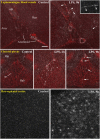Inflammation-inducible type 2 deiodinase expression in the leptomeninges, choroid plexus, and at brain blood vessels in male rodents
- PMID: 24601886
- PMCID: PMC3990842
- DOI: 10.1210/en.2013-2154
Inflammation-inducible type 2 deiodinase expression in the leptomeninges, choroid plexus, and at brain blood vessels in male rodents
Abstract
Thyroid hormone regulates immune functions and has antiinflammatory effects. In promoter assays, the thyroid hormone-activating enzyme, type 2 deiodinase (D2), is highly inducible by the inflammatory transcription factor nuclear factor-κ B (NF-κB), but it is unknown whether D2 is induced in a similar fashion in vivo during inflammation. We first reexamined the effect of bacterial lipopolysaccharide (LPS) on D2 expression and NF-κB activation in the rat and mouse brain using in situ hybridization. In rats, LPS induced very robust D2 expression in normally non-D2-expressing cells in the leptomeninges, adjacent brain blood vessels, and the choroid plexus. These cells were vimentin-positive fibroblasts and expressed the NF-κB activation marker, inhibitor κ B-α mRNA, at 2 hours after injection, before the increase in D2 mRNA. In mice, LPS induced intense D2 expression in the choroid plexus but not in leptomeninges, with an early expression peak at 2 hours. Moderate D2 expression along numerous brain blood vessels appeared later. D2 and NF-κB activation was induced in tanycytes in both species but with a different time course. Enzymatic assays from leptomeningeal and choroid plexus samples revealed exceptionally high D2 activity in LPS-treated rats and Syrian hamsters and moderate but significant increases in mice. These data demonstrate the cell type-specific, highly inducible nature of D2 expression by inflammation, and NF-κB as a possible initiating factor, but also warrant attention for species differences. The results suggest that D2-mediated T₃ production by fibroblasts regulate local inflammatory actions in the leptomeninges, choroid plexus and brain blood vessels, and perhaps also in other organs.
Figures







References
-
- De Vito P, Incerpi S, Pedersen JZ, Luly P, Davis FB, Davis PJ. Thyroid hormones as modulators of immune activities at the cellular level. Thyroid. 2011;21:879–890 - PubMed
-
- Inan M, Koyuncu A, Aydin C, Turan M, Gokgoz S, Sen M. Thyroid hormone supplementation in sepsis: an experimental study. Surg Today. 2003;33:24–29 - PubMed
Publication types
MeSH terms
Substances
Grants and funding
LinkOut - more resources
Full Text Sources
Other Literature Sources
Medical

